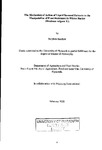The Mechanism of Action of Liquid Seaweed Extracts in the Manipulation of Frost Resistance in Winter Barley (Hordeum vulgare. L)
| dc.contributor.author | Burchett, Stephen | |
| dc.contributor.other | Faculty of Science and Engineering | en_US |
| dc.date.accessioned | 2013-11-19T08:38:53Z | |
| dc.date.available | 2013-11-19T08:38:53Z | |
| dc.date.issued | 2000 | |
| dc.identifier | NOT AVAILABLE | en_US |
| dc.identifier.uri | http://hdl.handle.net/10026.1/2744 | |
| dc.description.abstract |
Frost assays carried out on winter barley (Hordeum vulgare cv Igri) showed that a single (10ml I) application of liquid seaweed extract (LSE) marginally increased the frost resistance of non-acclimated (NA) plants by 2.3% compared to NA controls and cold-acclimated (CA) plants by 2.1% compared to CA controls. Three applications of LSE increased the frost resistance of NA plants by 16% compared to NA controls and CA plants by 7.5% compared to CA controls. These observations were durable in a small scale field trial where LSE increased plant dry weights (control 0.55, single LSE, 0.611 and multiple LSE 0.621 log dry weight), but rain following LSE application reduced LSE mediated frost resistance. Glasshouse growth trials illustrated that LSE enhanced tiller production (control 2.8, one LSE 3.8 and three LSE 4.5 tillers) and dry weight gain, but where precipitation followed LSE application, up to 3 days post application, the LSE mediated effect was not sustained. Protein analysis demonstrated that cold-acclimation and LSE treatments increased the total soluble protein content of winter barley. A single application of LSE increased the soluble protein content of NA plants by 36.7% and three applications of LSE to NA plants increased protein concentration by 86.5%. There was not a significant increase in the soluble protein concentration of LSE treated CA plants. There was a significant increase in the number of high molecular weight proteins and the up-regulation of a 118kDa and a 57kDa protein when plants were treated with LSE. However precipitation following LSE application adversely affected LSE mediated protein expression. A tentative immunological identification of the up-regulated proteins suggested that the 118kDa protein is a dehydrin. There was a 2 fold decrease in plant water potential of NA plants treated with three applications of LSE compared to controls and a similar decrease in plant water potential was observed in cold-acclimated plants. The duration of LSE mediated decline in water potential lasted for 6 days, post LSE application. However there was no significant reduction in the percentage water content of cold-acclimated and LSE treated plants. Differential scanning calorimetry demonstrated that both cold-acclimated and LSE treated plants had significantly less frozen water in their crown tissue compared to non-acclimated controls. Further thermal analysis (infrared thermography and thermocouple data) showed that both cold-acclimation and LSE treatments reduced the speed of water removal from plant cells to the extracellular ice (NA 4.06, NA3LSE 13.4, CA 15.7 and CA3LSE 19.31 minutes). It is hypothesised that both CA and LSE treatments are modifying plant water status, so that water becomes more structured at the physico-chemical level, and thus alters the osmotic behaviour of cellular water. This higher level of water structuring reduces frost damage by conserving the cellular water environment and thus reducing protein denaturation and membrane damage. | en_US |
| dc.description.sponsorship | Maxicrop International | en_US |
| dc.language.iso | en | en_US |
| dc.publisher | University of Plymouth | en_US |
| dc.title | The Mechanism of Action of Liquid Seaweed Extracts in the Manipulation of Frost Resistance in Winter Barley (Hordeum vulgare. L) | en_US |
| dc.type | Thesis | |
| plymouth.version | Full version | en_US |
| dc.identifier.doi | http://dx.doi.org/10.24382/3722 |
Files in this item
This item appears in the following Collection(s)
-
01 Research Theses Main Collection
Research Theses Main


